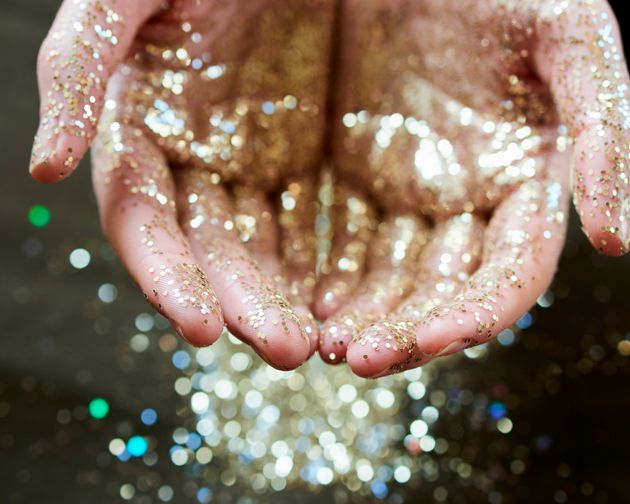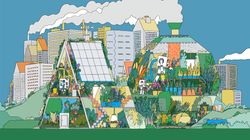When it comes to plastic, the predictions are bleak. It’s estimated that today’s more durable incarnations of the stuff – including bottles, beer pack rings and disposable nappies – will take over 450 years to decompose.
Sure, we’re waking up to the scale of the issue. Guides to eliminating the clear stuff from your life – we like How To Give Up Plastic by the Head of Oceans at Greenpeace, Will McCallum (£12.99, Penguin) – abound, while McDonald’s has fixed a start of September deadline to eliminate plastic straws from its UK outlets. But to conquer this thing, we need to educate ourselves on the hidden plastics, blended into other materials, lurking in our everyday buys, that we don’t know are there.
From receipts (yes) to glitter (yes) here’s the things to avoid – and the workarounds you need.
1. Sea salt
Sad but true, your de facto seasoning may be contaminated with tiny specks of plastic. “We’ve heard about fish containing microplastics. But what applies to fish also applies to sea salt,” says Shia Su, author of Zero Waste – Simple Life Hacks To Drastically Reduce Your Trash (£12.99, Skyhorse Publishing). “I stick to rock salt, preferably from the bulk bin.” A US-focused study from April 2018 found that, in the 12 brands of commercial sea salt tested, all contained traces of plastic debris, while a 2017 study analysing commercial salts originating from eight countries found similar results.
You can seek out premium rock salt or Pink Himalayan salt, if you want to swerve potential plastics.

2. Receipts
This is a super sneaky one to make your receipts last longer. “You may think they are from an environmentally friendly source, but that’s just the paper part,” Charlotte Watkivs, co-founder of blog A Zero Waste Life explains.
“People recycle them [receipts] thinking that’s the correct thing to do, not realising that they are contaminated with plastic.” Layered on top of many receipts is a sheen which comes courtesy of bisphenol A (BPA): a chemical found in plastic.
At the supermarket, decline your receipt, and for clothes and household goods, ask if you can have proof of purchase emailed to you. If you do end up with one, fold it so that the ink is on the inside, to avoid exposure to the chemical.
3. Fizzy drink cans
Think a drink can is just made of aluminium? In fact, beverage containers are often lined with a plastic coating, in order to prevent reactions between the drink and the can itself. While a more environmental choice than plastic bottles, especially if crafted from recycled aluminium, it’s something to be aware of. You can find out more by contacting specific drinks brands to ask if they’re using plastics in their cans, or try and pick up to-go hydration that comes in a glass bottle.

4. Plasters
We guess the clue’s in the first syllable, but we hadn’t made the plastic/plaster connection. Luckily, more eco solutions are here to switch to, with plenty of organic cotton varieties on the market. Another way to further reduce waste? ”I don’t buy the individually wrapped plasters, but the big roll and strips in a cardboard box,” says Su.
5. Sports clothes
Polyester is used in a lot of our clothing – it’s cheap and blends well with other fibres, making it a popular choice for manufacturers. Athletic wear, with its emphasis on things being form-fitting and stretchy, however, is often more likely to be comprised of the stuff. Now, the term ‘polyester’ just means a chain of repeating molecular units. The variety used the most, however, is polyethylene terephthalate (PET) – a plastic.
The problem here is that, when the clothes are washed, little traces of plastic can leak into the water supply. To get around this, zero waster Chloé Lepeltier, of sustainable living blog Conscious by Chloe, recommends a Guppy friend. These are wash bags designed to capture plastic fibres, preventing the latter from leaking out.

6. ‘Paper’ coffee cups
The paper-plastic mix that takeaway coffee cups are made out of was first brought to our attention by chef and environmental campaigner Hugh Fearnley-Whittingstall’s BBC One programme, ‘Hugh’s War On Waste.’ As to why the containers aren’t purely paper? “Paper cups are usually lined with a thin layer of plastic, or have a layer hidden between the paper to make it waterproof when they hold liquids,” Watkivs says.
Easy one to solve. Either have your morning cortado in the shop, or invest in a reuseable cup.
7. Glitter
So sparkly, but not so sustainable. Most glitter is formed from plastic, with colours layered on top. As such, they’re prime for eventually making their way into the oceans, where they may be ingested by marine life. Next festival, buy biodegradable glitter, and shimmer guilt-free.

8. Crisp packets
Salt and vinegar deep ridge really has a hold on our hearts – a recent report from Mintel showed that crisps and ‘crisp-style snacks’ (Wotsits, etc.) are regularly eaten by 90% of adults in the UK.
No crisp packets are recyclable at the moment, and are formed of various layers of plastics. Sadly, there are no alternatives out there right now. But emailing your number one crisp brand and asking them about their plans to make their packaging greener is a good way to pile on the pressure.


